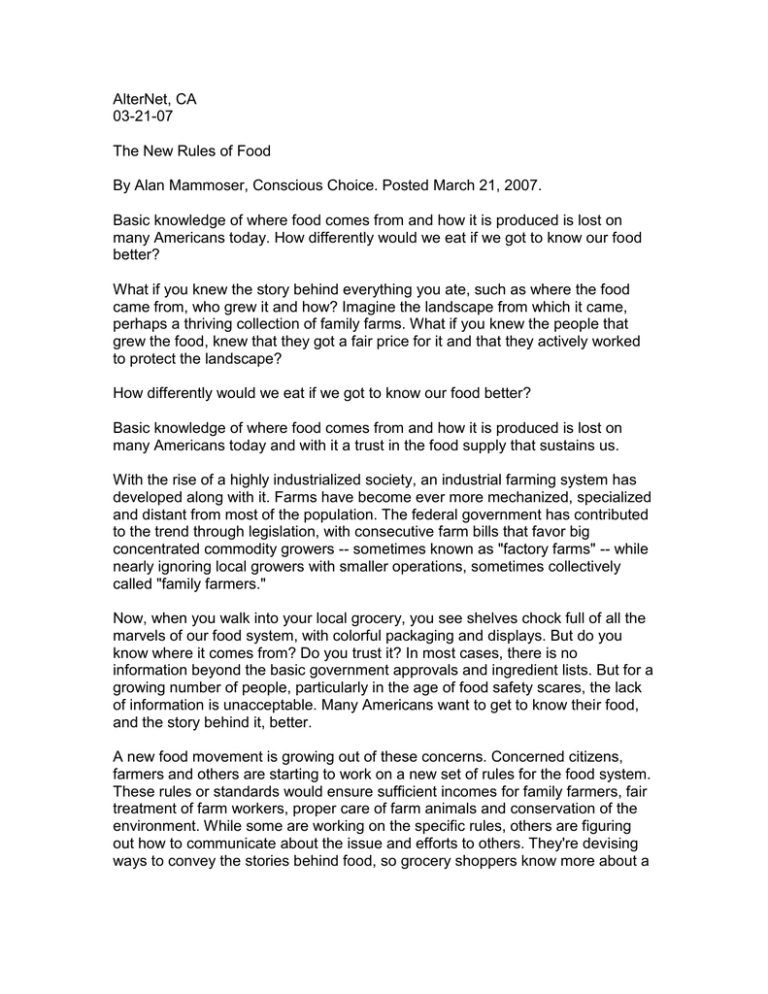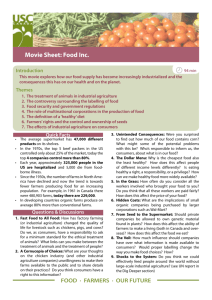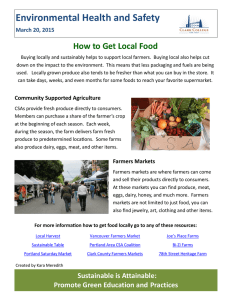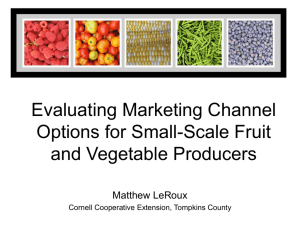AlterNet, CA 03-21-07 The New Rules of Food
advertisement

AlterNet, CA 03-21-07 The New Rules of Food By Alan Mammoser, Conscious Choice. Posted March 21, 2007. Basic knowledge of where food comes from and how it is produced is lost on many Americans today. How differently would we eat if we got to know our food better? What if you knew the story behind everything you ate, such as where the food came from, who grew it and how? Imagine the landscape from which it came, perhaps a thriving collection of family farms. What if you knew the people that grew the food, knew that they got a fair price for it and that they actively worked to protect the landscape? How differently would we eat if we got to know our food better? Basic knowledge of where food comes from and how it is produced is lost on many Americans today and with it a trust in the food supply that sustains us. With the rise of a highly industrialized society, an industrial farming system has developed along with it. Farms have become ever more mechanized, specialized and distant from most of the population. The federal government has contributed to the trend through legislation, with consecutive farm bills that favor big concentrated commodity growers -- sometimes known as "factory farms" -- while nearly ignoring local growers with smaller operations, sometimes collectively called "family farmers." Now, when you walk into your local grocery, you see shelves chock full of all the marvels of our food system, with colorful packaging and displays. But do you know where it comes from? Do you trust it? In most cases, there is no information beyond the basic government approvals and ingredient lists. But for a growing number of people, particularly in the age of food safety scares, the lack of information is unacceptable. Many Americans want to get to know their food, and the story behind it, better. A new food movement is growing out of these concerns. Concerned citizens, farmers and others are starting to work on a new set of rules for the food system. These rules or standards would ensure sufficient incomes for family farmers, fair treatment of farm workers, proper care of farm animals and conservation of the environment. While some are working on the specific rules, others are figuring out how to communicate about the issue and efforts to others. They're devising ways to convey the stories behind food, so grocery shoppers know more about a cut of meat or a bag of beans and can use this information to make better choices. This food and farming conversation is gathering force, appropriately, in the Midwest. Many leading thinkers are gathering in March at the Family Farmed Expo (familyfarmed.org), a two-day event in Chicago that contains events for the general public. Local experts on the subject will be on hand as well. "When national organic food standards were adopted in the early 90s, there was a choice," says Jim Slama of Sustain USA, a Chicago-based non-profit that works on food and farming issues. "At that time, the feds chose to emphasize environmental standards in the strictest sense, to certify whether the food production system avoided artificial fertilizers and chemicals. But they chose to ignore other values related to producing and selling food, values that many people care about." Slama and his colleagues are at the forefront of a "food convergence." Previously, food-related issues were addressed separately as individual groups focused on organics, local production, fair trade or family farm issues. Today, these groups are coming together to look at food from all angles with the belief that collectively, they can have far greater impact. Four key topics of discussion include certifying family farms; fair trade standards; organics and beyond; and local food and flavor. Certifying Family Farms Fred Kirschenmann has watched with alarm as the number of independent family farms decline across the Midwest. The North Dakota farmer and senior fellow at Iowa State University's Leopold Center for Sustainable Agriculture noted that this tragic disappearance was occurring even as demand was growing for specialty food products. "New markets are opening," says Kirschenmann. "In many cases, markets for organic foods, but they really take organic to another level. They come from peoples' rising desire to buy food that protects the land and animals, supports farm families and farm workers. These markets demand food products that independent family farmers can, by their very nature, best provide." This new demand for food can be summed up in three things food must convey: memory, story and relationship. People want food that carries the land's qualities and nutrients to their tables -- that's its memory. They want to know where it came from and follow it to its source -- that's its story. And they want to enjoy a trusting relationship through real communication with the producer. Kirschenmann joined like-minded rural advocates and food activists to form the Association of Family Farms (AFF). The organization's goal is to differentiate themselves in the marketplace by forming cooperatives and creating their own unique brands, which they will certify with a special seal. Like the ubiquitous "UL" (Underwriters Laboratories) label on household goods, the AFF seal will appear on food products from meat to wheat. It will certify food in three ways: 1) environmental stewardship on the farm; 2) social standards, such as fair treatment of farm workers; and 3) fair business practices including fair compensation for family farmers. AFF is composed of farmers from local marketing organizations and co-ops and is gradually expanding through regional committees. In addition to the AFF seal, Kirschenmann foresees an interactive website that will provide detailed information about the food, and the farmers and practices used to produce it. Fair Trade Standards For AFF to work, it needs solid rules and agreed-upon standards by which to judge whether a food item deserves the seal. The group is drawing upon the Portland-based Food Alliance, whose certification programs support sustainable agriculture. Their standards are comprehensive and touch on every aspect of the farm economy and call upon farmers and ranchers for the following: Michael Sligh of the North Carolina-based Rural Advancement Foundation is working to adapt international fair trade standards, such as those well-recognized for coffee, to the domestic food market. "The standards are tools to help small farmers make a claim, to make their products more unique and more valuable," Sligh says. Organic and Beyond Organic Valley is a LaFarge, Wisconsin-based cooperative that is owned by 900 independent farmers, most with small to mid-sized family farms. The Organic Valley label provides a powerful seal that guarantees social justice and environmental care. Now, the company is moving toward adopting some form of fair trade standard. "Organic and beyond," is how the company's CEO, George Siemon, describes it, signaling Organic Valley's desire to reach buyers who care about a wide range of values in their food. Erin Ford, a project coordinator at the company, notes that good standards require good metrics. "To create useful standards, we need to answer basic questions, such as 'what is a family farm?'" she says. "Another is, 'what is local food?'" Organic Valley has done much to provide answers, just through the guidelines it has established for its members. "We've got good working definitions, based upon our experience as a national brand working through a regional business model," says Ford. For example, to define a family farm, the company sets out certain thresholds, such as the number of heads of cattle (the maximum allowed for members is 500 without special approval, although their farmer average is 65). Their local milk is seen in a broad yet well-defined regional context, with seven major trade areas across the country broken up into the following regions: Pacific Northwest, California, Rocky Mountain, Texas, Midwest, Northeast and New England. Their goal is to ship within their regions, so the milk in the stores comes from relatively local producers. Local Food and Flavor To tell the food story, to convey trust, means food must become more local, in both a real and a figurative sense. The food buyer must come to know the landscape, the scene of the harvest, whether it be across the continent or in the buyer's own region. Locality plays a big role in any new standards for food. The creation, or restoration, of local food systems goes to the heart of what people love most about food, namely, flavor. The international Slow Food movement sees this instinctively, placing the concern for good flavor into broader agendas for land conservation and the survival of diverse plant and animal varieties. Slow Food brings the discussion of fair trade down to where it really matters most: the plate. "The universal aspect of food is pleasure," says Erika Lesser of Slow Food USA. "It's not gluttony. It's just the reality of how food motivates people. It's like doing good by eating well." This appeal to taste could bring huge numbers of people into the fair trade fold, by getting them to look for good -- and good-tasting -- meals. Slow Food projects bring producers together around agreed-upon standards for special heritage varieties, such as raw milk cheese, Gravenstein Apples or other high value or unique foods. There is still a lot of work ahead to make the "memories, stories and relationships" of food accessible to most city folk who live far away from farms and food production. The evolving conversation -- with new farmer-oriented standards, seals and methods to communicate food stories -- may create a growing swell that will shake our food system, and our ways of interacting with it, to its very roots.





